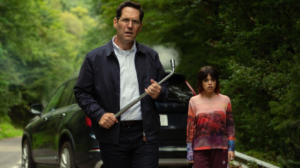The Irishman: Review

Image courtesy of Netflix
By Garrett Farrell
The Academy of Motion Picture Arts and Sciences announced the nominees for this year’s Academy Awards, the most prestigious awards in American cinema, on January 13, 2020. Martin Scorsese’s Netflix original The Irishman was honored with 10 nominations, including the award for Best Picture.
The movie follows the story of Frank Sheeran, played by Robert De Niro, a hitman who has made his way into the upper echelons of the New Jersey/Philadelphia mob and acts frequently as an envoy between this mob’s boss, Russell Buffalino, played by Joe Pesci, and Teamster boss Jimmy Hoffa, played by Al Pacino. The story reaches its climax with a dramatic explanation of the disappearance of Hoffa’s disappearance.
Both Joe Pesci and Al Pacino earned nominations for the Best Supporting Actor with stellar performances, which is not at all unexpected; Pacino has played the role of mob boss since the beginning of his career, and could likely have played it in his sleep at this point. The film was shot beautifully, earning it a nomination for Best Cinematography, and Scorsese proved his acumen for making mob movies endure, earning a nod for Best Director. Additionally, the film received nominations for Outstanding Score and several technical awards.
In spite of the numerous awards the film was nominated for, it still has some glaring flaws, namely its lack of focus and some egregious faults in its pacing. The lack of focus becomes increasingly irritating as the film progresses; it seems as if the viewer is given superfluous information that is not explicitly necessary every five minutes and there are characters who play integral roles in the story that are rarely on screen. It is likely that this flaw stems from a screenwriter who has not had to make a mobster movie that is as dependent on its cast as this one in some time, which was clearly Scorsese’s desired product; if this wasn’t the intended result, he wouldn’t have hired two Corleones to play the leads.
The issue with the pacing in some way stems from the film’s lack of focus as well as, ironically, the stellar performances given by De Niro, Pacino, and Pesci. The film focuses too much on establishing that the dynamic between Buffalino, Hoffa, and Sheeran exists. The film breezes through the relationships between these characters failing to show how they affect the story. While it is entirely true to say that the movie is driven by the performances these actors give, it is equally fair to say that their talent was somewhat wasted by a script that has them talk about matters as trivial as bread and wine for long stretches.
The problems in pacing create a much more serious problem for any movie of this type. The Irishman is almost incapable of building any suspense until the last 45 minutes of its three-and-a-half-hour runtime, and even then the suspense is resolved in 15 minutes. In the prototypical mobster movies, there is typically an undertone of suspense that pervades the entirety of the movie, because the viewer knows that at any moment any character could be “whacked.”
Building suspense in this way was perfected by The Godfather (of course, most aspects of movie-making were perfected in The Godfather); from the get-go, the viewer feels a sense of dread that stays with them until it is resolved in the climax. This is simply not the case in The Irishman and the lack of suspense lessens the catharsis that should come from certain moments in the film.
Taking into account these flaws, the movie is as good as it can be. Scorsese directs the film to perfection, and the performances by Pesci, Pacino, and De Niro cannot be praised enough. Scorsese and these three actors are able to develop the main characters in spite of glaring flaws in pacing which would cripple a movie made by almost anyone else this millennium. Even minor characters played by Ray Romano and Harvey Keitel have moments where they shine.
In fact, the phrase that best describes The Irishman is “cast driven.” The movie has a remarkable cast and makes full use of it at all times. There is especially outstanding chemistry between Pacino and De Niro, whose dynamic plays into the climax of the story more than that of any other characters.
Beyond the exceptional performances and the remarkable visuals, what is most striking about the movie is its powerful statement on human mortality and legacy.
“It’s a movie about looking upon what you’ve left behind and squaring up with all of it… Marty [Scorsese]… creates a film that methodically transforms itself into an exploration of our very own universally shared mortality,” said actor Leonardo DiCaprio when asked for a quote about the film, according to The Hollywood Reporter.
Nowhere is this theme more evident than in the last half hour of the movie, when the viewer is taken through almost 30 years of history at a break-neck pace. It culminates with De Niro’s character confessing some of the things which he has done to a priest and seeking absolution for actions that he cannot reverse, a poignant statement on the permanency of a person’s legacy after their death.






